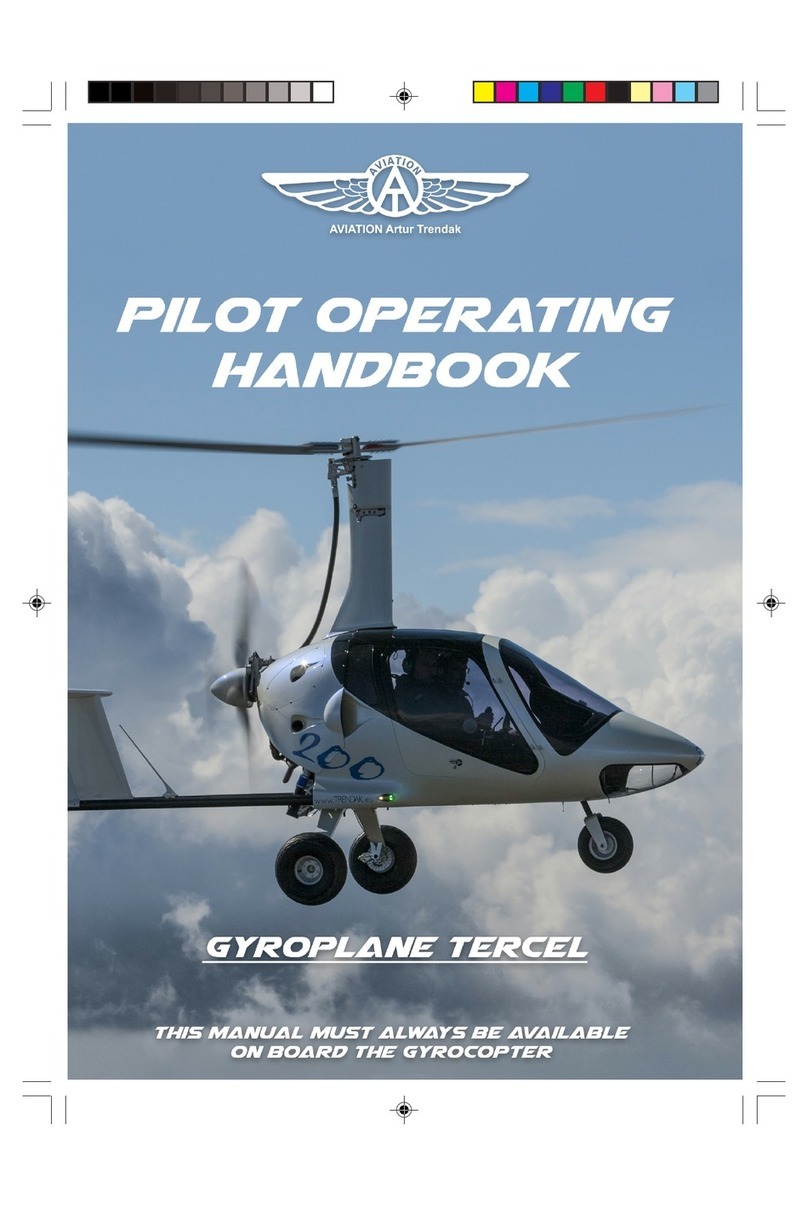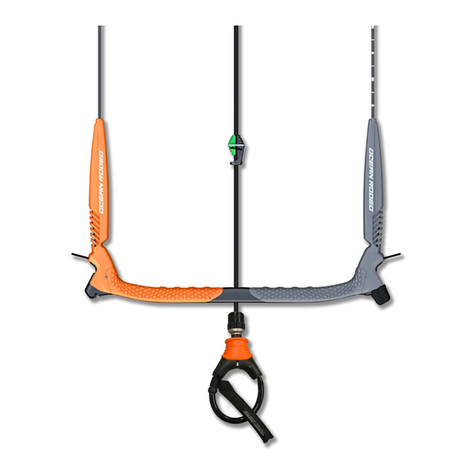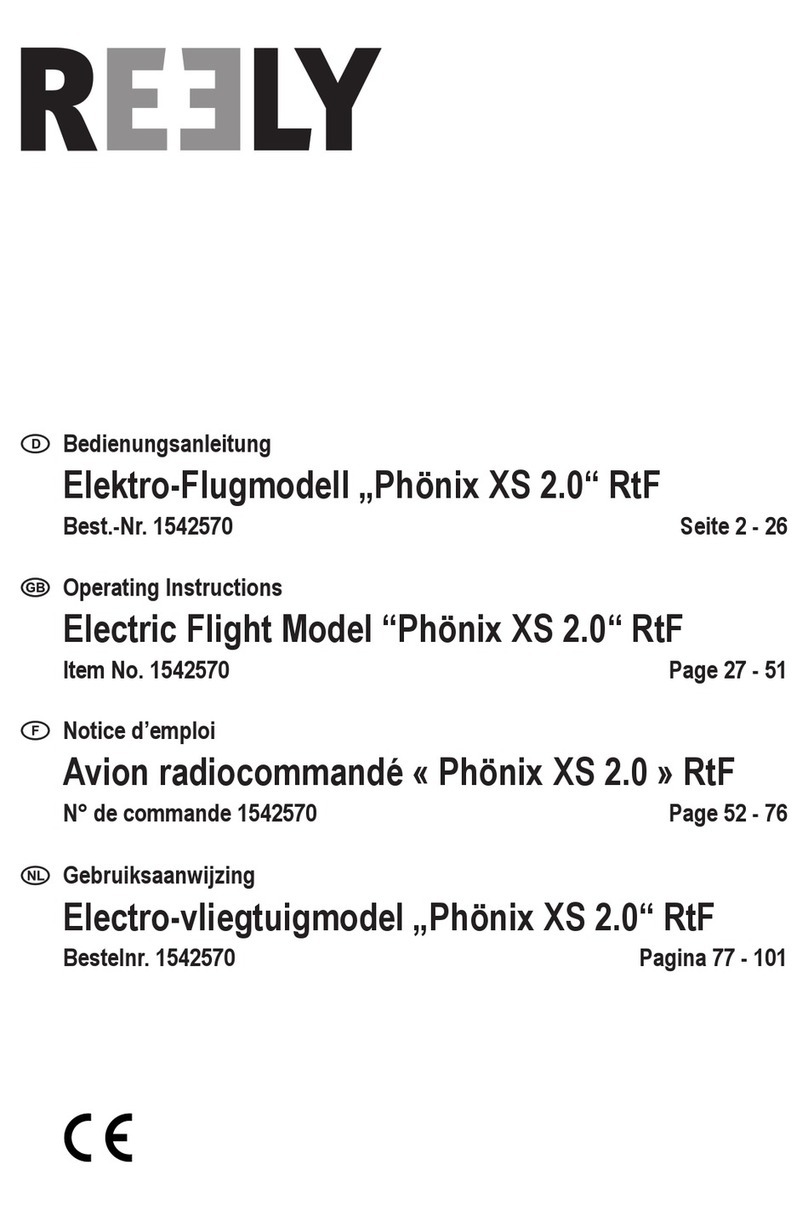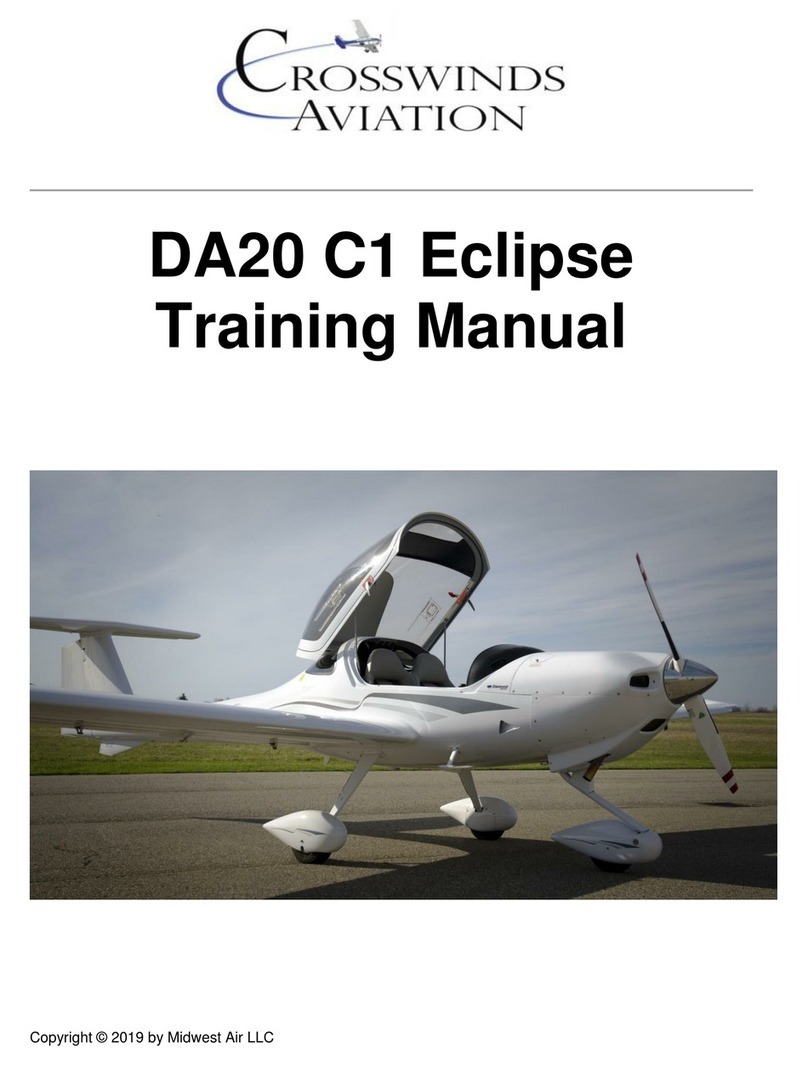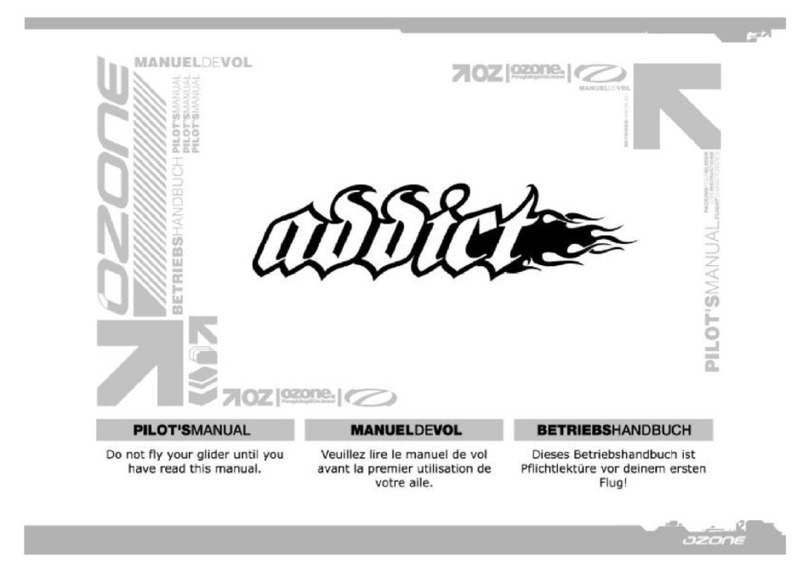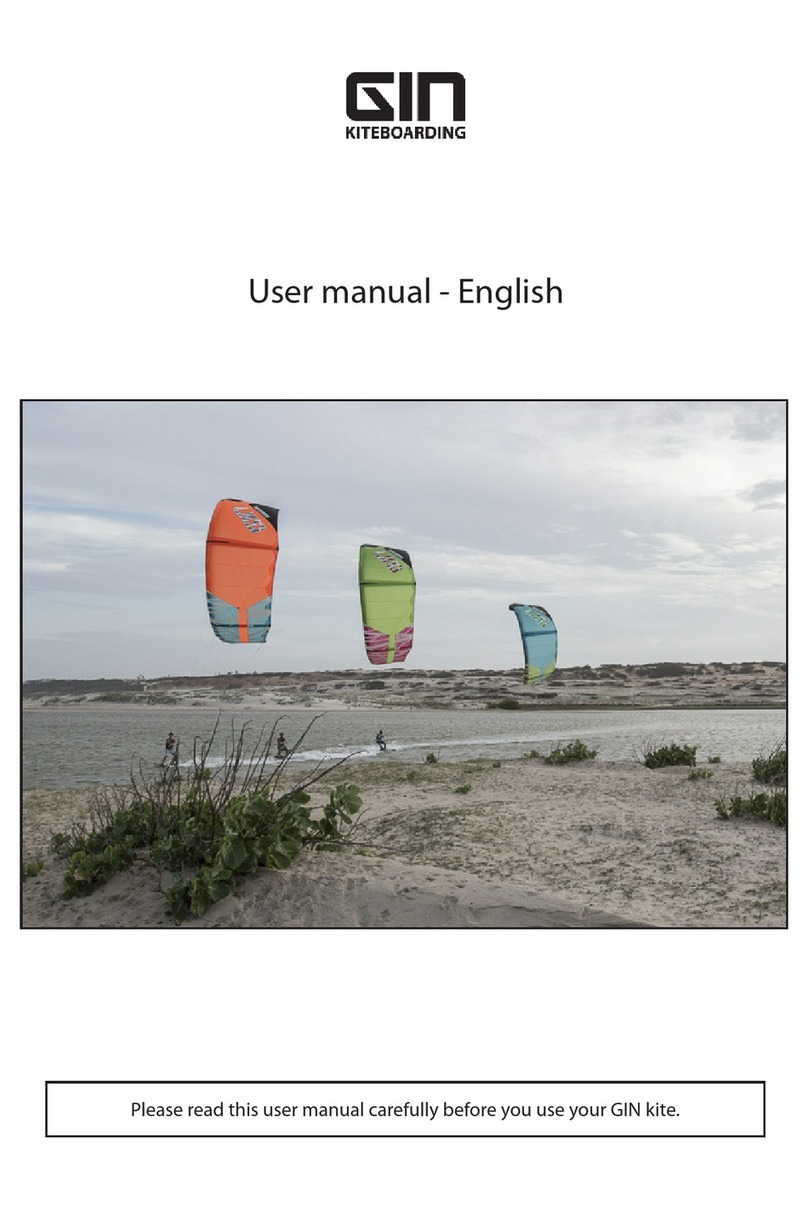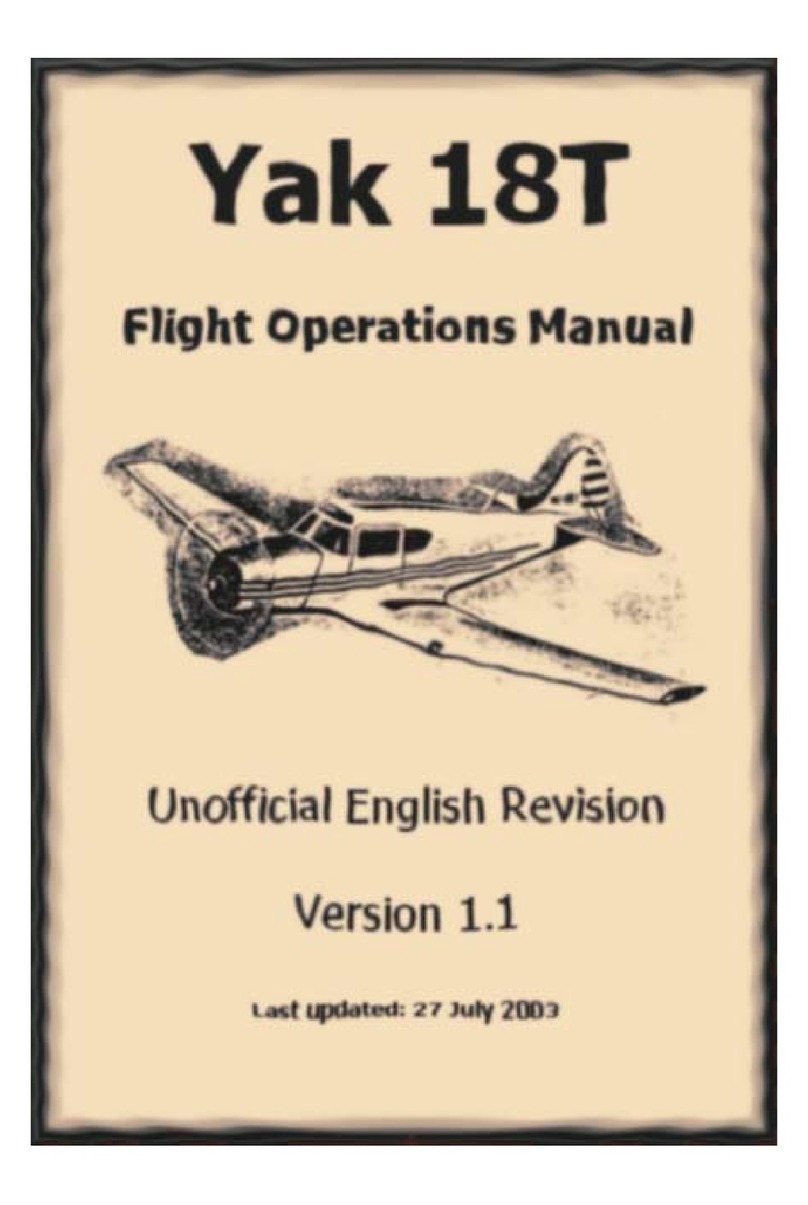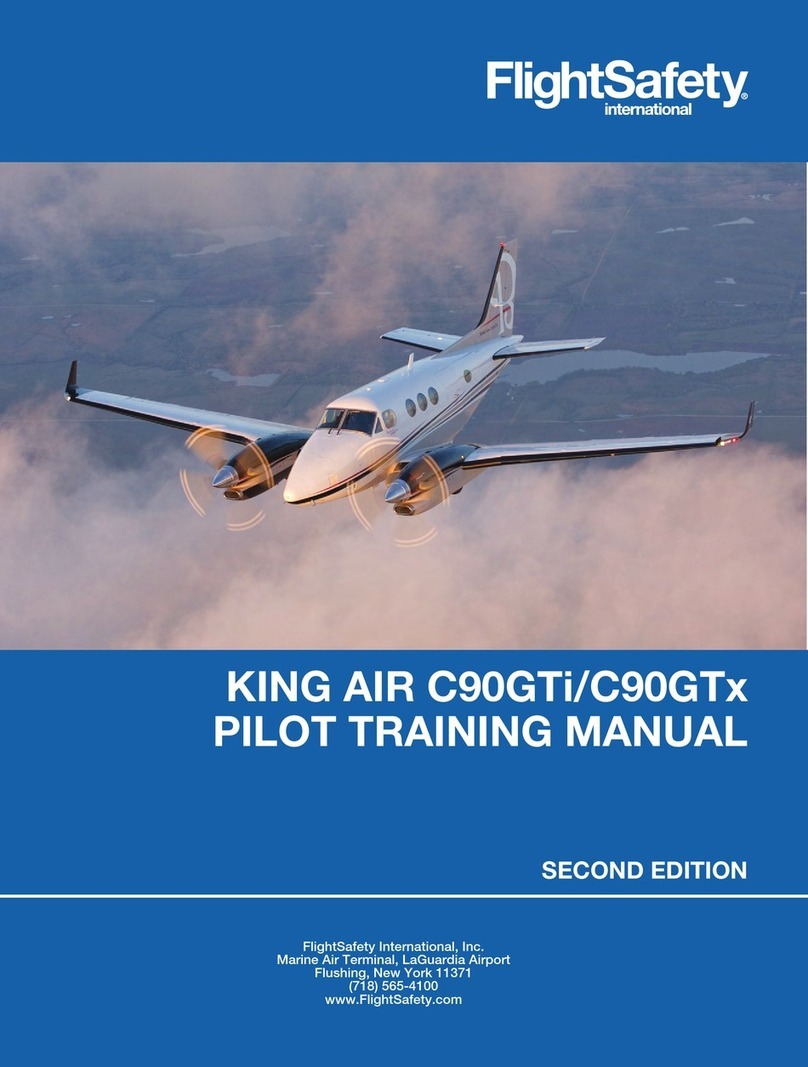Aeropilot Legend 540 User manual

Serial Number: 1203
2
TABLE OF CONTENTS
1Introduction...................................................................................................................................4
1.1 Ten Rules of Safe Flying.......................................................................................................4
1.2 Instructions for use................................................................................................................5
1.3 Important information ...........................................................................................................5
1.4 Location of decals .................................................................................................................5
2Flight manual data ........................................................................................................................8
2.1 Data on commissioning.........................................................................................................8
2.2 Record of aircraft operator / owner.......................................................................................9
2.3 Aircraft data.........................................................................................................................10
2.4 Aircraft drawing..................................................................................................................11
2.5 Brief technical description...................................................................................................12
2.6 Controls...............................................................................................................................13
2.7 Engineering data..................................................................................................................13
2.8 Aircraft equipment ..............................................................................................................14
3Operating limits..........................................................................................................................18
3.1 Speeds..................................................................................................................................18
3.2 Wind speed limits................................................................................................................18
3.3 Powerplant limits.................................................................................................................18
3.4 Weights................................................................................................................................19
3.5 Allowed turns......................................................................................................................19
3.6 Load factors (per UL-2 regulation).....................................................................................19
3.7 Types of operation...............................................................................................................19
4Emergency procedures................................................................................................................19
4.1 Engine failure......................................................................................................................19
4.2 In case of fire.......................................................................................................................21
4.3 In case of vibrations ............................................................................................................22
4.4 Landing gear failure ............................................................................................................23
4.5 Recovering from unintentional spin....................................................................................23
4.6 Using the rescue system......................................................................................................23
5Standard procedures....................................................................................................................24
5.1 Pre-flight inspection............................................................................................................24
5.2 Refueling.............................................................................................................................25
5.3 Checks on entering the cabin...............................................................................................26
5.4 Starting the engine...............................................................................................................26
5.5 Engine test...........................................................................................................................27
5.6 Taxiing.................................................................................................................................27
5.6 Mandatory actions before take-off –on runway holding point...........................................27
5.8 Take-off ...............................................................................................................................28
5.9 Climbing..............................................................................................................................28
5.10 Mandatory actions after take-off......................................................................................29
5.11 During flight ....................................................................................................................29
5.12 Flying in turbulent air......................................................................................................29
5.13 Descent ............................................................................................................................29
5.14 Final approach .................................................................................................................29
5.15 Landing............................................................................................................................30
5.16 Go-around........................................................................................................................30

Serial Number: 1203
3
5.17 Actions after landing........................................................................................................30
5.18 Stopping the engine .........................................................................................................30
5.19 Stopping the aircraft, parking ..........................................................................................31
5.20 Flying in rain, snow.........................................................................................................31
5.21 Assembly and disassembly of the aircraft .......................................................................31
5.22 Long-term storage and transport......................................................................................32
5.23 Determining the location of centre of gravity..................................................................33
6.1 25-hour inspection...............................................................................................................35
6.2 100-hour inspection.............................................................................................................35
7Performance................................................................................................................................37
7.1 Speed measurement system calibration...............................................................................37
7.2 Stall speeds..........................................................................................................................38
7.3 Take-off performance..........................................................................................................38
7.4 Landing performance ..........................................................................................................38
7.5 Climbing performance.........................................................................................................39
7.6 Flight ...................................................................................................................................39
7.7 Endurance and range...........................................................................................................40
7.8 Verified performance with crosswind..................................................................................40
7.9 Optimum gliding speed .......................................................................................................40
7.10 Ceiling..............................................................................................................................40

Serial Number: 1203
4
1 Introduction
1.1 Ten Rules of Safe Flying
I. Observe all regulations applicable to operation of ultralight (UL) aircraft.
II. Do not overestimate your piloting skills and never show off in front of spectators.
Quite to the contrary, practice emergency landing at suitable locations.
III. Watch the weather and its development all the time. Do not attempt long flight if
storms, clouds or icing are likely to occur.
IV. Monitor fuel level frequently, not only by watching the needles, but also by
comparing the flight time with actual fuel consumption.
V. Always choose your bearing and altitude so that you will be able to make
emergency landing.
VI. Always fly with a sufficient speed margin, especially during the take-off and
landing.
VII. Do not perform nor mimic any aerobatic figures (e.g. stall turns) even if you feel
that your piloting skills and aircraft handling qualities would allow aerobatic
manoeuvres.
VIII. Under no circumstances, not even for a very short period of time, exceed the never-
exceed speed Vne.
IX. Do not minimize navigation. Do not fly into unknown areas without appropriate
navigation preparation and aids (map, compass).
X. Fly only when you are in good physical and mental condition.

Serial Number: 1203
5
1.2 Instructions for use
1) This Manual is issued by aircraft manufacturer and it is recommended being kept on board of
the aircraft during each flight.
2) Records shall be made legibly and indelibly, no page may be torn out of the Manual.
3) Manual with complete records forms a part of the aircraft technical documentation.
4) Total number of take-offs and operating time shall be transferred from old into new logbook,
along with the information about latest service bulletin performed.
5) The aircraft´s owner is responsible for correctness of operation records.
1.3 Important information
Changes and Amendments to this Manual
Any changes to applicable regulations or to this aircraft's construction will be published in the form
of a bulletin (e.g. in the Pilot magazine). It is the responsibility of each aircraft owner to implement
the change (or to have it implemented) and to record the change in the respective part of this
Manual.
Owner of the aircraft and every
operator of the aircraft shall read this
Manual carefully and familiarize
themselves with its contents.
This aircraft is not subject to the certification by the Civil AviationAuthority
of the Czech Republic and it is operated entirely on the user’s own risk.
Deliberate spins, falls and aerobatics are prohibited.
Any damage to the aircraft shall be reported to applicable inspector-technician. The inspector-
technician will recommend the method of repair, supervise the repair and will make a technical
inspection after the repair has been completed. A record shall be entered into the aircraft
documentation.
1.4 Location of decals
A) SLZ decal (English translation of the text is in bold frame on previous page)
Location: right part of instrument panel, above center.

Serial Number: 1203
6
B) Operating data and limitations
OPERATING DATAAND
LIMITATIONS
Call Sign
OK–RUL 91
Type/Name
LEGEND 540
Serial No./Year of manufacture
1203/2011
Empty weight
322kg
Max. take-off weight
472.5kg
Payload
143kg
Stall speed
63kmph
Never exceed speed
255kmph
Max. speed in turbulent air
170kmph
Max. speed with 30° flaps
135kmph
Max. speed with 40° flaps
135kmph
Fuel tank capacity
100L
Location: left part of left instrument panel.

Serial Number: 1203
7
C) Registration decal
SLZ REGISTRATION DECAL
Call Sign
OK–RUL 91
Type/Name
LEGEND 540
Manufacturer
AEROPILOT Ltd.
Serial No./Year of manuf.
1203/2012
Empty weight
322kg
Max. take-off weight
472.5kg
Payload
143kg
Location: center tunnel, in front of central control.
D) Payload decal
Fuel tank capacity / Max. payload
L
Payload / kg
Full tanks
100
80
3/4 of tanks
75
97
1/2 of tanks
50
115
1/4 of tanks
25
133
30min. fuel reserve
10
143
Location: right part of right instrument panel.

Serial Number: 1203
8
2 Flight manual data
2.1 Data on commissioning
Ultralight aircraft, aerodynamically-controlled.
Name/Model:
LEGEND 540
The aircraft has obtained ULL type certificate.

Serial Number: 1203
9
2.2 Record of aircraft operator / owner
Aircraft owner: AEROPILOT Ltd.
Name: Jaromír Smékal, Ing.
Address: Jeníkovská 1815, 28601 Čáslav
Birth Certificate (CIN): CZ27108431
Date, from –to:
Call Sign: OK–RUL 91
Change of Owner: .......................................................
Name: ..........................................................................
Address: ......................................................................
Birth Certificate (CIN): ...............................................
Date, from –to: ...........................................................
Call Sign: OK–.............................................................
Change of Owner: ........................................................
Name: ...........................................................................
Address: .......................................................................
Birth Certificate (CIN): ................................................
Date, from –to: ............................................................
Call Sign: OK–..............................................................
Change of Owner: .........................................................
Name: ............................................................................
Address: ........................................................................
Birth Certificate (CIN): .................................................
Date, from –to: .............................................................
Call Sign: OK–...............................................................
Change of Owner: ..........................................................
Name: .............................................................................
Address: .........................................................................
Birth Certificate (CIN): ..................................................
Date, from –to: ..............................................................
Call Sign: OK–................................................................

Serial Number: 1203
10
2.3 Aircraft data
Aircraft data
Model
Airframe ULLa
Engine
Propeller
Rescue System
Manufacturer
AEROPILOT Ltd.
Rotax 912 ULS
Woodcomp
Varia 170/2R
GALAXY
5/560
Serial No.
1203
6.779.011
22042
1909.11.1415
5662
Place & Year of
Manufacture
2012
2011
2012
2011
Other Data

Serial Number: 1203
11
2.4 Aircraft drawing

Serial Number: 1203
12
2.5 Brief technical description
Characteristic
The Legend ultralight aircraft is a two-seat, strut high-wing monoplane of all-composite structure
designed for sport, recreational or tourist flying. Favourable flight characteristics make the aircraft
suitable for flight training. Sufficient performance allows glider towing. The aircraft features
spacious crew and baggage compartments. Large doors provide for comfortable boarding of crew
and loading of baggage. Adjustable seats allow the pilots of all heights to find comfortable position.
A stiff Kevlar cabin, four-point seat harnesses and rocket assisted rescue system provide maximum
safety of crew in emergency situations.
Technical description of aircraft components
A) Airframe
1. The fuselage is made of carbon composite. Bulkheads are bonded into integrally stiffened
skin to receive forces from the landing gear, rescue system, stabilizer, rudder, safety harnesses, and
wings. There are two doors with a central-lock system mounted on flush hinges on the sides of
fuselage, opening against flight direction.
2. Sandwich-type single-spar wings made of carbon-composite house two fuel tanks within
leading section. Wings are fitted with a slotted Fowler flaps. Wings have rectangular centre section
with trapezoidal tips. MS 313 wing profile is used. Banking control by ailerons with differentiated
deflection 10° down and 23° up . With aileron deflection up, a nose rises from profile, providing
favourable yawing moment. The wing strut is made of aluminium profile.
3. Trapezoidal fixed part of elevator is fixed into the fuselage bulkheads by pins and screws.
Aerodynamically balanced elevator has electrically servo-actuated trim tab. The elevator deflection
is 21° up and 13° down.
4. Fixed part of trapezoidal swept vertical tail is offset from a longitudinal axis to eliminate an
angular propeller flow. The elevator deflection is approximately 24°.
5. Rudder and ailerons have dual cable control, elevator is rod-operated. Yoke controls. Rudder
and nose landing gear are operated by pedals with top-mounted shafts, which greatly improves the
kinematics of controls. Combined central controller allows control of the engine, landing gear
brakes, parking brake, and wing flaps, the flaps being driven by central actuator through Bowden
cables.
6. Tricycle landing gear with steerable nose wheel. Main wheels –size 15x6-6 - are provided
with hydraulic disc brakes. Amortization by composite legs. The nose wheel fitted with spring and
hydraulic shock absorber. The front wheel has size 12 x 4 –4. All wheels provided with fairings.
Tire inflation of all wheels is for 2,3 bar pressure.
B) Powerplants
Rotax 912 and 912S engines are used most frequently, providing excellent dynamic and flight
characteristics. Rotax 912 and 912S engines are four-stroke, four-cylinder engines of “boxer”
configuration, having air-cooled cylinders with water-cooled heads, integrated reduction gearbox,
and two carburetors. For more information, see the engine instructions for use.

Serial Number: 1203
13
Caution!
Neither of the engines mentioned above is certified as an aircraft engine. Even with
utmost attention during engine manufacture, engine failure may occur at any time
during flight and the pilot bears full responsibility for the consequences. According to
UL1 regulation, the pilot must always select bearing and altitude allowing him/her to
glide down and land safely at suitable location.
C) Propeller
Fixed-pitch PESZKE propeller as well as VARIA 170/2R adjustable-pitch propeller may be used.
For the description of the propeller delivered with your aircraft, see the instructions for the propeller
installation and maintenance, delivered along with the aircraft.
D) Equipment
The aircraft may be equipped with traditional analogue instruments, together with GPS navigation
or a glass cockpit incorporating flight, engine and navigation instruments, including a transponder.
2.6 Controls
Pedals –pressing left pedal turns aircraft left both on the ground and in the air, and vice versa.
Hand controls –pulling the yoke backwards, towards the pilot, raises the nose of aircraft (the angle
of attack increases) and the aircraft climbs. Pushing the yoke forward dives the aircraft. Turning the
yoke to the left banks the aircraft to the left, and vice versa.
Engine throttle –moving combined controller located on the middle-panel forward from its central
position, in the flight direction, increases engine output, and vice versa.
Brake control –pulling combined controller backwards, in the opposite direction of taxiing, brakes
the aircraft. Moving the controller backwards and pressing the detent locks the brake (parking
brake). To release the parking brake, pull brake lever or combined controller backwards.
2.7 Engineering data
(a) Dimensions
Wing span 9.1m
Length 7.05m
Height, total 2.6m
Wing surface 10.84m2
Wing aspect ratio 7.64
Depth of MAC (mean aerodynamic chord) 1200mm
Wing profile MS 313 B
At root 1300mm
At tip 880 mm
Wing flaps surface 1.75m2

Serial Number: 1203
14
Flaps deflections 15° / 30° / 45°
Horizontal tail plane span 2.8m
Horizontal tail plane surface 2.24m2
Vertical tail plane surface 1.04m2
Control surface deflections:
Ailerons up ......... 23° down ......... 12°
Elevator up ......... 21°down ......... 10°
Rudder left ......... 23°right ......... 25°
(b) Weights
Empty weight, per UL–2 320,5kg
Take-off weight, maximum 472.5kg
(c) Engine
Type (brief description): Rotax 912S 100HP –four-stroke, four-cylinder engine, air-cooled
cylinders with water-cooled heads, integrated reduction gearbox, dual electronic ignition.
Swept volume 1400ccm
Take-off power, max. 73.5kW@5800rpm
Cruising power, max. 69.0kW@5500rpm
Dry weight 56kg
including accessories 72kg
Fuel (fuel grade, octane index) Natural 95
Oil (type) SHELL HELIX H x 7AV 10W-40
Oil capacity 3L
Reduction gear (gear ratio) 2.43:1
Fuel tank volume –main tank 100L
(d) Propeller
Diameter / pitch at 75% In-flight adjustable propeller SR-3000/3N
Weight 5kg
Material Composite
The propeller shall be sent to the manufacturer for inspection in case of even the slightest
damage or if crack is found. Flying with damaged propeller may endanger life and limb and is
prohibited.
2.8 Aircraft equipment
(a) Instruments
Type Serial No.
Speed indicator LUN 1106 673
Altimeter BG-3E 1316
Compass CM-13 016
Climb & descent indicator BC10-1B 1605
Tachometer VDO COCKPIT 333025015 x
Cylinder temperature gauge CHT/100 ROAD 0542
Oil-temperature gauge R 2011 0561
Oil-pressure gauge ROAD 0531

Serial Number: 1203
15
Type Serial No.
Exhaust-gas thermometer x x
Fuel-pressure gauge EMRS ……………
Manifold pressure gauge x x
GPS …………… ……………
Radio ATR 500 505867 11
Transponder EM 800 908094-11
(b) Ballistic Rescue System
Model, manufacturer, serial No. GALAXY 5/560
Activation By pulling the handle on central panel
Descent speed, max. (m/s) 6,6m/s
At take-off weight 560kg
Speed at activation, max. 310kmph
(c) Battery (type, parameters)
Type 508 901
Voltage 12V
Ah rating 8
Weight 2.9kg
Location On firewall, at the highest point of engine compartment
Notice Only the charger designed for gel batteries may be used to
charge the battery. Use of other charger will destroy
the battery.
(d) Location of Controllers
Ignition switch Center panel, left-hand side
Starter Center panel, left-hand side
Choke Central controller –left instrument panel
Throttle Central controller –bottom part of middle panel
Brakes Central controller –bottom part of middle panel
Longitudinal trim Control yokes
Wing flaps Engine throttle + right instrument panel
Closing of the cabin Front section of the door
Rescue system Central bottom panel
Radio Central dashboard panel
GPS Central dashboard panel

Serial Number: 1203
16
Equipment layout
Drawing:
1 - Starter button 15 - Transponder
2 - Speedometer 16 - Rescue system
3 - Compass 17 - Oil cooler flap
4 - Altimeter 18 - Right fuel tank cock
5 - Climb and descent indicator 19 - Left fuel tank cock
6 - Ball 20 - Propeller pitch crank
7 - RPM 21 - Two-needle fuel level gauge
8 - Heating control 22 - Fuel pressure gauge
9 - Choke control 23 - Oil pressure gauge
11 - Main switch 24 - Voltmeter
12 - Ignition switch 25 - Trim indicator, flaps
13 - Radio 26 - Engine temperature gauge
14 - GPS 27 - Oil temperature gauge

Serial Number: 1203
17
Central controller functions
Drawing
30 - Flaps extend
31 - Flaps retract
32 - Engine throttle
33 - Wheel brake/parking brake

Serial Number: 1203
18
3 Operating limits
3.1 Speeds
All speeds stated in this Manual are Indicated Air Speeds IAS!
Never-exceed speed, VNE = 255kmph
This speed must not be exceeded under any circumstances!
Stalling speed at maximum take-off weight and at the
landing configuration, VSO: 60kmph
Maximum allowed speed with flaps fully deflected, VFE: 135kmph
Flaps deflection:
Degrees/Use 1 –15° / Take-off 135kmph
Degrees/Use 2 –30° / Landing 135kmph
Degrees/Use 3 –40° / Landing 135kmph
Maximum speed in turbulent air: 202kmph
Maximum manoeuvre speed, VA: 180kmph
Do not apply full deflections above this speed
3.2 Wind speed limits
Maximum allowed headwind speed 10m/s
Maximum allowed crosswind speed: 4m/s
Tailwind take-off and landing should be avoided.
3.3 Powerplant limits
Maximum allowed speed: 5800rpm for 5 minutes
Maximum continuous speed: 5500rpm
Idling speed, approximately: 1400rpm
Maximum cylinder head temperature: 130°C
Maximum oil temperature: 135°C
Minimum air temperature at starting: -25°C
Maximum air temperature at starting: 50°C
Oil pressure: 1.15 –4.0bar

Serial Number: 1203
19
3.4 Weights
Minimum crew weight: 60kg
Maximum payload: 143kg
Maximum take-off weight: 472.5kg
Empty weight 322kg
Maximum COG locations from front edge of wing:
Forward limit 21.6% bMAC
Aft limit: 35.6% bMAC
Max. baggage weight 15kg
3.5 Allowed turns
Tight turns up to 60° banking angle, climbing and diving up to 30° from horizontal plane.
Intentional spins, falls and aerobatics are PROHIBITED!
3.6 Load factors (per UL-2 regulation)
Maximum positive load factor in the centre of gravity: 4.0
Maximum negative load factor in the centre of gravity: -2.0
3.7 Types of operation
Only daylight flights are allowed, under VFR (ground-contact) rules.
All other flights are prohibited.
4 Emergency procedures
This section describes recommended procedures for resolving emergency situations which could
occur during operation.
Strict adherence to inspection and maintenance schedule prescribed by the manufacturer reduces the
probability of a failure to absolute minimum.
4.1 Engine failure
1) During take-off run
Throttle to idle
Ignition switch off
Brake according to actual conditions

Serial Number: 1203
20
2) During take-off (in air)
Maintain speed 120kmph minimum
Less than 300ft above terrain –land in the direction of flight, manoeuvring the aircraft out
of obstructions
Detect wind direction and speed
Apply flaps as necessary
Shut off fuel cock
Shut off the ignition
Tighten safety harnesses
Main switch off
3) In flight
Dive and glide, maintain speed 120kmph minimum
More than 300ft above terrain –:select suitable landing location
If cause of engine failure is discovered (e.g. empty fuel tank) and flight altitude allows it, try
restarting the engine according to the procedure below:
If engine does not restart or if flight altitude drops below safe level, select suitable landing
location and proceed according to previous section.
4) Restarting engine in flight
May be only performed at safe flight altitude to allow safe emergency landing with engine off.
Fuel cock open, check amount of fuel in selected tank
Fuel pump switch on
Ignition switch on
Throttle up to 1/3 of throttle, not more
Flight speed 120–140kmph
Press start button
Flying with engine off
If engine fails, it is necessary to maintain speed 120kmph.
Table of contents



